Atmospheric diving suit
An atmospheric diving suit (ADS) is a small one-person articulated anthropomorphic submersible which resembles a suit of armour, with elaborate pressure joints to allow articulation while maintaining an internal pressure of one atmosphere. The ADS can be used for very deep dives of up to 2,300 feet (700 m) for many hours, and eliminates the majority of significant physiological dangers associated with deep diving; the occupant need not decompress, there is no need for special gas mixtures, nor is there danger of decompression sickness or nitrogen narcosis.[1] Divers do not even need to be skilled swimmers, but the disadvantage is limited dexterity.
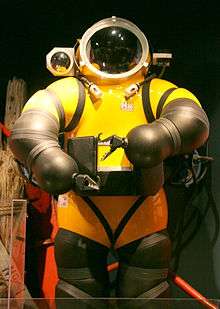
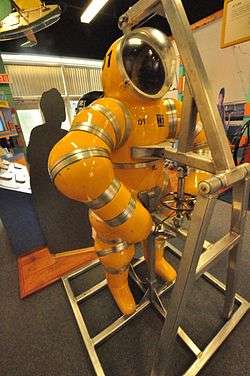
Atmospheric diving suits in current use include the Newtsuit, Hardsuit and the WASP, all of which are self-contained hard suits that incorporate propulsion units. The hardsuit is constructed from cast aluminum (forged aluminum in a version constructed for the US Navy for submarine rescue); the upper hull is made from cast aluminum, while the bottom dome is machined aluminum. The WASP is of glass-reinforced plastic (GRP) body tube construction.
Purpose and requirements
The underwater environment exerts major physiological stresses on the diver, which increase with depth, and appear to impose an absolute limit to diving depth at ambient pressure. An atmospheric diving suit is a small submersible with a pressure hull which accommodates a single occupant at an internal pressure of about one atmosphere. The provision of hollow arm spaces with pressure resistant joints to carry manually operated manipulators, and usually separate leg spaces, similarly articulated for locomotion, makes a suit resemble a bulky suit of plate armour, or an exoskeleton , with elaborate joint seals to allow articulation while maintaining internal pressure.
An atmospheric diving suit is equipment intended primarily to isolate the occupant from the ambient pressure of the underwater environment, and provide any necessary life-support while the suit is in use. While using the suit, the diver will expect to perform useful work, and get to and from the place where the work is to be done. These functions require sufficient mobility, dexterity and sensory input to do the job, and this will vary depending on the details of the work. Consequently, the work possible in an atmospheric suit is limited by the suit construction.
Mobility at the surface and on deck can be managed by launch and recovery systems, Mobility underwater generally requires neutral or moderately negative buoyancy, and either the ability to walk or swim, or the use of finely controllable thrusters. Both walking and thruster propulsion have been applied with some success. Swimming has not been effective.
The dexterity to perform useful work is limited by joint mobility and geometry, inertia, and friction, and has been one of the more difficult engineering challenges. Haptic perception through manipulators is a major limitation on finer control, as the friction of the joints and seals greatly reduces the sensitivity available.
Operator visual input is relatively easy to provide directly by using transparent viewports. A wide field of view can be achieved simply and structurally effectively by using a transparent partial dome over the diver's head. Close-up views of the manipulators are limited by joint flexibility and geometry of the suit's arms. External sound and temperature perception are greatly attenuated, and there is no sense of touch through the suit. Communications must be provided by technology, as there is normally no-one else in the immediate vicinity.
Design constraints
The main environmental factors affecting design are the ambient hydrostatic pressure of the maximum operating depth, and ergonomic considerations regarding the potential range of operators. The structure and mechanics of the suit must reliably withstand the external pressure, without collapsing or deforming sufficiently to cause seals to leak or joints to experience excessive friction, and the full range of movement must not change the internal or external displaced volume.
- ambient pressure, structural stability, constant volume geometry, buoyancy, insulation, mass, bulk.
- ergonomic considerations - strength of the user, operating forces on joints, field of vision, general underwater conditions
Hazards and failure modes
- structural: leaks, implosion, lockup of joints, loss of buoyancy.
- systems failures: loss of power, communications, propulsion,
- life-support: breathing air, temperature control
History
Early designs

In 1715, British inventor John Lethbridge constructed a "diving suit". Essentially a wooden barrel about 6 feet (1.8 m) in length with two holes for the diver's arms sealed with leather cuffs, and a 4-inch (100 mm) viewport of thick glass. It was reportedly used to dive as deep as 60 feet (18 m), and was used to salvage substantial quantities of silver from the wreck of the East Indiaman Vansittart, which sank in 1719 off the Cape Verde islands.[2]
The first armored suit with real joints, designed as leather pieces with rings in the shape of a spring (also known as accordion joints), was designed by Englishman W. H. Taylor in 1838. The diver's hands and feet were covered with leather. Taylor also devised a ballast tank attached to the suit that could be filled with water to attain negative buoyancy. While it was patented, the suit was never actually produced. It is considered that its weight and bulk would have rendered it nearly immobile underwater.[2]
Lodner D. Phillips designed the first completely enclosed ADS in 1856. His design comprised a barrel-shaped upper torso with domed ends and included ball and socket joints in the articulated arms and legs. The arms had joints at shoulder and elbow, and the legs at knee and hip. The suit included a ballast tank, a viewing port, entrance through a manhole cover on top, a hand-cranked propeller, and rudimentary manipulators at the ends of the arms. Air was to be supplied from the surface via hose. There is no indication, however, Phillips' suit was ever constructed.[2]

The first properly anthropomorphic design of ADS, built by the Carmagnolle brothers of Marseilles, France in 1882, featured rolling convolute joints consisting of partial sections of concentric spheres formed to create a close fit and kept watertight with a waterproof cloth. The suit had 22 of these joints: four in each leg, six per arm, and two in the body of the suit. The helmet possessed 25 individual 2-inch (50 mm) glass viewing ports spaced at the average distance of the human eyes.[3] Weighing 830 pounds (380 kg), the Carmagnole ADS never worked properly and its joints never were entirely waterproof. It is now on display at the French National Navy Museum in Paris.[4]
Another design was patented in 1894 by inventors John Buchanan and Alexander Gordon from Melbourne, Australia. The construction was based on a frame of spiral wires covered with waterproof material. The design was improved by Alexander Gordon by attaching the suit to the helmet and other parts and incorporating jointed radius rods in the limbs. This resulted in a flexible suit which could withstand high pressure. The suit was manufactured by British firm Siebe Gorman and trialed in Scotland in 1898.


American designer MacDuffy constructed the first suit to use ball bearings to provide joint movement in 1914; it was tested in New York to a depth of 214 feet (65 m), but was not very successful. A year later, Harry L. Bowdoin of Bayonne, New Jersey, made an improved ADS with oil-filled rotary joints. The joints use a small duct to the interior of the joint to allow equalization of pressure. The suit was designed to have four joints in each arm and leg, and one joint in each thumb, for a total of eighteen. Four viewing ports and a chest-mounted lamp were intended to assist underwater vision. Unfortunately there is no evidence that Bowdoin's suit was ever built, or that it would have worked if it had been.[2]
Atmospheric diving suits built by German firm Neufeldt and Kuhnke were used during the salvage of gold and silver bullion from the wreck of the British ship SS Egypt, an 8,000 ton P&O liner that sank in May 1922. The suit was relegated to duties as an observation chamber at the wreck's depth of 170 metres (560 ft),[5] and was successfully used to direct mechanical grabs which opened up the bullion storage. In 1917, Benjamin F. Leavitt of Traverse City, Michigan, dived on the SS Pewabic which sank to a depth of 182 feet (55 m) in Lake Huron in 1865, salvaging 350 tons of copper ore. In 1923, he went on to salvage the wreck of the British schooner Cape Horn which lay in 220 feet (67 m) of water off Pichidangui, Chile, salvaging $600,000 worth of copper. Leavitt's suit was of his own design and construction. The most innovative aspect of Leavitt's suit was the fact that it was completely self-contained and needed no umbilical, the breathing mixture being supplied from a tank mounted on the back of the suit. The breathing apparatus incorporated a scrubber and an oxygen regulator and could last for up to a full hour.[6]
In 1924 the Reichsmarine tested the second generation of the Neufeldt and Kuhnke suit to 530 feet (160 m), but limb movement was very difficult and the joints were judged not to be fail-safe, in that if they were to fail, there was a possibility that the suit's integrity would be violated. However, these suits were used by the Germans as armored divers during World War II and were later taken by the Western Allies after the war.
In 1952, Alfred A. Mikalow constructed an ADS employing ball and socket joints, specifically for the purpose of locating and salvaging sunken treasure. The suit was reportedly capable of diving to depths of 1,000 feet (300 m) and was used successfully to dive on the sunken vessel SS City of Rio de Janeiro in 328 feet (100 m) of water near Fort Point, San Francisco. Mikalow's suit had various interchangeable instruments which could be mounted on the end of the arms in place of the usual manipulators. It carried seven 90-cubic foot high pressure cylinders to provide breathing gas and control buoyancy. The ballast compartment covered the gas cylinders. For communication, the suit used hydrophones.[7]
The modern suit
Peress' Tritonia

Although various atmospheric suits had been developed during the Victorian era, none of these suits had been able to overcome the basic design problem of constructing a joint which would remain flexible and watertight at depth without seizing up under pressure.
Pioneering British diving engineer, Joseph Salim Peress, invented the first truly usable atmospheric diving suit, the Tritonia, in 1932 and was later involved in the construction of the famous JIM suit. Having a natural talent for engineering design, he challenged himself to construct an ADS that would keep divers dry and at atmospheric pressure, even at great depth. In 1918, Peress began working for WG Tarrant at Byfleet, United Kingdom, where he was given the space and tools to develop his ideas about constructing an ADS. His first attempt was an immensely complex prototype machined from solid stainless steel.
In 1923, Peress was asked to design a suit for salvage work on the wreck of SS Egypt which had sunk in the English Channel. He declined, on the grounds that his prototype suit was too heavy for a diver to handle easily, but was encouraged by the request to begin work on a new suit using lighter materials. By 1929 he believed he had solved the weight problem, by using cast magnesium instead of steel, and had also managed to improve the design of the suit's joints by using a trapped cushion of oil to keep the surfaces moving smoothly. The oil, which was virtually non-compressible and readily displaceable, would allow the limb joints to move freely at depths of 200 fathoms (1,200 ft; 370 m), where the pressure was 520 psi (35 atm). Peress claimed that the Tritonia suit could function at 1,200 ft (370 m) although this was never proven.[8]
In 1930, Peress revealed the Tritonia suit.[9] By May it had completed trials and was publicly demonstrated in a tank at Byfleet. In September Peress' assistant Jim Jarret dived in the suit to a depth of 123 m (404 ft) in Loch Ness. The suit performed perfectly, the joints proving resistant to pressure and moving freely even at depth. The suit was offered to the Royal Navy which turned it down, stating that Navy divers never needed to descend below 90 m (300 ft). In October 1935 Jarret made a successful deep dive to more than 90 m (300 ft) on the wreck of the RMS Lusitania off south Ireland, followed by a shallower dive to 60 metres (200 ft) in the English Channel in 1937 after which, due to lack of interest, the Tritonia suit was retired.
The development in atmospheric pressure suits stagnated in the 1940s through 1960s, as efforts were concentrated on solving the problems of deep diving by dealing with the physiological problems of ambient pressure diving instead of avoiding them by isolating the diver from the pressure. Although the advances in ambient pressure diving (in particular, with scuba gear) were significant, the limitations brought renewed interest to the development of the ADS in the late 1960s.[8]
The JIM suit
The Tritonia suit spent about 30 years in an engineering company's warehouse in Glasgow, where it was discovered, with Peress' help, by two partners in the British firm Underwater Marine Equipment, Mike Humphrey and Mike Borrow, in the mid-1960s.[8][10][11] UMEL would later classify Peress' suit as the "A.D.S Type I", a designation system that would be continued by the company for later models. In 1969, Peress was asked to become a consultant to the new company created to develop the JIM suit, named in honour of the diver Jim Jarret.[12]
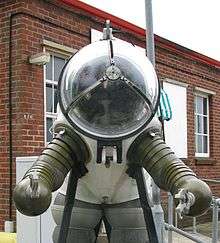
The first JIM suit was completed in November 1971 and underwent trials aboard HMS Reclaim in early 1972. In 1976, the JIM suit set a record for the longest working dive below 490 feet (150 m), lasting five hours and 59 minutes at a depth of 905 feet (276 m). The first JIM suits were constructed from cast magnesium for its high strength-to-weight ratio and weighed approximately 1,100 pounds (498.95 kg) in air including the diver. They were 6 ft 6 inches (1.98 m) in height and had a maximum operating depth of 1,500 feet (457 m). The suit had a positive buoyancy of 15 to 50 pounds (6.8 to 22.7 kg). Ballast was attached to the suit's front and could be jettisoned from within, allowing the operator to ascend to the surface at approximately 100 feet (30 m) per minute.[13] The suit also incorporated a communication link and a jettisonable umbilical connection. The original JIM suit had eight annular oil-supported universal joints, one in each shoulder and lower arm, and one at each hip and knee. The JIM operator received air through an oral/nasal mask that attached to a lung-powered scrubber that had a life support duration of approximately 72 hours.[14] Operations in arctic conditions with water temperatures of -1.7°C for over 5 hours were successfully carried out using woolen thermal protection and neoprene boots. In 30°C water the suit was reported to be uncomfortably hot during heavy work.[15]
As technology improved and operational knowledge grew, Oceaneering upgraded their fleet of JIMs. The magnesium construction was replaced with glass-reinforced plastic (GRP) and the single joints with segmented ones, each allowing seven degrees of motion, and when added together giving the operator a very great range of motion. In addition, the four-port domed top of the suit was replaced by a transparent acrylic one that was taken from Wasp, this allowed the operator a much-improved field of vision. Trials were also carried out by the Ministry of Defence on a flying Jim suit powered from the surface through an umbilical cable. This resulted in a hybrid suit with the ability of working on the sea bed as well as mid water.[15]
In addition to upgrades to the JIM design, other variations of the original suit were constructed. The first, named the SAM Suit (designated A.D.S III), was a completely aluminium model. A smaller and lighter suit, it was more anthropomorphic than the original JIMs and was depth-rated to 1,000 feet (300 m). Attempts were made to limit corrosion by the use of a chromic anodizing coating applied to the arm and leg joints, which gave them an unusual green color. The SAM suit stood at 6 feet 3 inches (1.91 m) in height, and had a life support duration of 20 hours. Only three SAM suits would be produced by UMEL before the design was shelved. The second, named the JAM suit (designated A.D.S IV), was constructed of glass-reinforced plastic (GRP) and was depth-rated for around 2,000 feet (610 m).[16]
Current suits

In 1987, the "Newtsuit" was developed by the Canadian engineer Phil Nuytten, and a version was put into production as the "Hardsuit" by Hardsuits International.[17] The Newtsuit is constructed to function like a 'submarine you can wear', allowing the diver to work at normal atmospheric pressure even at depths of over 1,000 feet (300 m). Made of wrought aluminium, it had fully articulated joints so the diver can move more easily underwater. The life support system provides 6–8 hours of air, with an emergency back-up supply of an additional 48 hours. The Hardsuit was used to salvage the bell from the wreck of the SS Edmund Fitzgerald in 1995. The latest version of the Hardsuit designed by Oceanworks, the "Quantum 2", uses higher power commercially available ROV thrusters for better reliability and more power as well as an atmospheric monitoring system to monitor the environmental conditions in the cabin. A more recent design by Nuytten is the Exosuit, a relatively lightweight and low powered suit intended for marine research.[18] It was first used in 2014 at the Bluewater and Antikythera underwater research expeditions.[19]
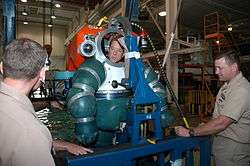
_from_the_salvage_ship_USS_Grasp_(ARS_51).jpg)
The ADS 2000 was developed jointly with OceanWorks International and the US Navy in 1997,[20] as an evolution of the Hardsuit to meet US Navy requirements. The ADS2000 provides increased depth capability for the US Navy's Submarine Rescue Program. Manufactured from forged T6061 aluminum alloy it uses an advanced articulating joint design based on the Hardsuit joints. Capable of operating in up to 2,000 feet (610 m) of seawater for a normal mission of up to six hours it has a self-contained, automatic life support system.[21] Additionally, the integrated dual thruster system allows the pilot to navigate easily underwater. It became fully operational and certified by the US Navy off southern California on August 1, 2006, when Chief Navy Diver Daniel Jackson submerged to 2,000 feet (610 m).[22]
From the project's beginning until 2011, the US navy spent $113 million on the ADS.[23]
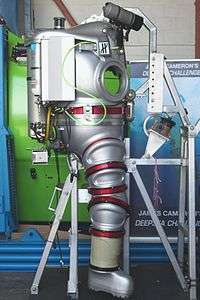
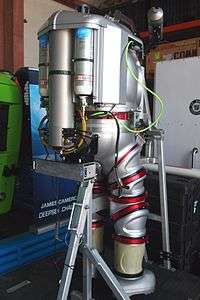
See also
- Human factors in diving equipment design – Influence of the interaction between the user and the equipment on design
- Space suit – A garment worn to keep a human alive in the harsh environment of outer space
- Submersible – Small watercraft able to navigate under water
References
- "WASP Specifications" (PDF). Archived from the original (PDF) on 3 March 2014. Retrieved 27 February 2014.
- Thornton, Mike; Randall, Robert; Albaugh, Kurt (March–April 2001). "Then and Now: Atmospheric Diving Suits". UnderWater magazine. Archived from the original on December 9, 2008. Retrieved 18 March 2012.
- "The Carmagnolle Brothers Armoured Dress". Historical Diving Times (37). Autumn 2005.
- "Historique" (in French). Association Les Pieds Lourds. Retrieved 6 April 2015.
- Pickford, Nigel (1998). Lost Treasure Ships of the 20th Century. Washington, DC: National Geographic Society. p. 152. ISBN 0792274725.
- Marx, Robert F (1990). The History of Underwater Exploration. Courier Dover Publications. pp. 79–80. ISBN 0-486-26487-4.
- Burke, Edmund H (1966). The Diver's World: An Introduction. Van Nostrand. p. 112.
- Loftas, Tony (7 June 1973). "JIM: homo aquatico-metallicum". New Scientist. 58 (849): 621–623. ISSN 0262-4079.
Enthusiasm for these pressure-resisted suits waned with the evolution of free-diving during and immediately after the Second World War. ... [T]he major innovative impetus was reserved almost exclusively for scuba gear
- Acott, Chris (1999). "A brief history of diving and decompression illness". South Pacific Underwater Medicine Society Journal. 29 (2). ISSN 0813-1988. OCLC 16986801. Archived from the original on 5 September 2011. Retrieved 6 April 2015.
- Taylor, Colin (October 1997). "Jim, but not as we know it". Diver. Archived from the original on 2014-12-26.. The article was reprinted, without the author's name and slightly abbreviated as: "The Joseph Peress Diving Suit". The Scribe, Journal of Babylonian Jewry (71): 24. April 1999.
- "Jim, but not as we know it". Retrieved 6 April 2015.. This article seems to be mostly based on the article in The Scribe (1999)
- Carter Jr, RC (1976). "Evaluation of JIM: A One-Atmosphere Diving Suit". US Navy Experimental Diving Unit Technical Report. NEDU-05-76. Retrieved 2008-07-22.
- Kesling, Douglas E (2011). Pollock, NW (ed.). "Atmospheric Diving Suits – New Technology May Provide ADS Systems that are Practical and Cost-Effective Tools for Conducting Safe Scientific Diving, Exploration, and Undersea Research". Diving for Science 2011. Proceedings of the American Academy of Underwater Sciences 30th Symposium. Dauphin Island, AL. Retrieved 6 April 2015.
- Carter Jr, RC (1976). "Evaluation of JIM: A One-Atmosphere Diving Suit". US Navy Experimental Diving Unit Technical Report. NEDU-05-76. Retrieved 6 April 2015.
- Curley, MD; Bachrach, AJ (September 1982). "Operator performance in the one-atmosphere diving system JIM in water at 20 degrees C and 30 degrees C". Undersea Biomedical Research. 9 (3): 203–12. PMID 7135632. Retrieved 6 April 2015.
- Nuytten, P (1998). "Life support in small one-atmosphere underwater work systems". Life Support & Biosphere Science. 5 (3): 313–7. PMID 11876198.
- Kesling, Doug E (2011). Pollock, NW (ed.). "Atmospheric Diving Suits – New Technology May Provide ADS Systems that are Practical and Cost-Effective Tools for Conducting Safe Scientific Diving, Exploration, and Undersea Research". Diving for Science 2011. Proceedings of the American Academy of Underwater Sciences 30th Symposium. Dauphin Island, AL. Retrieved 6 April 2015.
- "The Exosuit: What Tony Stark Would Wear Underwater". Gizmodo. Retrieved 6 April 2015.
- "New technology: The Exosuit". Return to Antikythera. Woods Hole Oceanographic Institution. 2014. Retrieved 21 September 2016.
- "Military ADS". OceanWorks International. 2015. Retrieved 6 April 2015.
- Logico, Mark (3 August 2006). "Navy Chief Submerges 2,000 Feet, Sets Record". U.S. Navy. Archived from the original on 22 May 2011. Retrieved 13 May 2011.
- Logico, Mark G (7 August 2006). "Navy Diver Sets Record with 2,000 foot Dive". Navy News. Archived from the original on 30 August 2006.
- Department of the Navy Fiscal Year 2017 Budget Estimates (PDF) (Report). US Department of the Navy. 31 Jan 2011. p. 164.
Further reading
- Harris, Gary L (1995). Ironsuit: The History of the Atmospheric Diving Suit. Best Pub. Co. ISBN 0-941332-25-X.
External links
| Wikimedia Commons has media related to Atmospheric diving suits. |